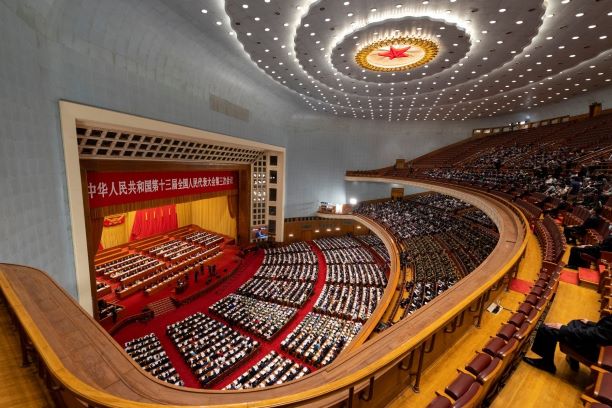China’s government work report reveals more practical, flexible approaches for economic development
By Li Zheng, Yan Yunming, People’s Daily
The third session of the 13th National People’s Congress (NPC) opens at the Great Hall of the People in Beijing, capital of China, May 22. Photo by Weng Qiyu/People’s Daily Online
A series of major measures were unveiled by a government work report at the opening of the third session of the 13th National People’s Congress (NPC), indicating the firm resolution of the Communist Party of China (CPC) Central Committee and the State Council to stabilize the Chinese economy, and further establish market expectations and enhance development confidence.
According to the government work report, China’s deficit-to-GDP ratio this year is projected at more than 3.6 percent, and the country will make further tax and fee cuts of about 500 billion yuan ($70 billion). Besides, the country will increase financial support to keep business operations stable; for example, the policy allowing micro, small, and medium businesses to postpone principal and interest repayments on loans will be further extended till the end of March next year – payments on all inclusive loans of micro and small businesses eligible for this policy should also be deferred.
At present, the COVID-19 pandemic is still rampant outside China, and epidemic prevention and control has evolved into a regular practice in the country. The convening of the “two sessions” under such background injected not only strong confidence into the Chinese people, but also positive energy into the world.
It is because of the special background that the government work report has adjusted expectations and goals out of consideration of the epidemic. A major change that has received wide attention is the absence of the annual economic growth targets. The move aims to guide each party concerned to better maintain stability in six key areas, namely employment, financial operations, foreign trade, foreign investment, domestic investment, and expectations, and to better safeguard jobs, people’s basic livelihood, market entities, food and energy security, the stability of industrial and supply chains, and the smooth running of communities.
“Under the current circumstances, not setting a specific growth target will allow us to be more focused on key tasks such as expanding domestic demand,” said He Lifeng, head of China’s National Development and Reform Commission, on the sidelines of the ongoing “two sessions.”
In fact, the quantitative economic indicators have been broken down into related indicators in fiscal, monetary and other related policies, He said. The sudden outbreak of the COVID-19 epidemic exerted huge impacts on the Chinese economy, and many indicators in Q1, and even those today, are not comparable to the previous figures, He added.
As China’s economy is deeply integrated into the global economy, it is hard to predict the future development due to uncertainties from the globally spreading coronavirus pandemic, he noted.
To cope with special situations with special approaches reflects the adeptness and calmness of the Chinese economy. Regarding macro control targets, to safeguard jobs, people’s basic livelihood, market entities, food and energy security, the stability of industrial and supply chains, and the smooth running of communities, is a priority of the country’s mission to maintain stability in the six key areas. It is a move aiming at securing the lower limits of performances.
By doing so, the country will be able to stabilize its economic fundamentals, and thus consolidate the foundation for building a moderately prosperous society in all respects. To safeguard jobs, people’s basic livelihood, and market entities will enable China to establish market expectation and policy orientation, and to coordinate the joint efforts of different sectors and places. Besides, by securing employment, development of small- and medium-sized enterprises, and social stability, China will see large potential of economic growth. Once domestic and overseas situation recovers, a sound supply-demand cycle will be established to drive economic growth.
The absence of exact GDP targets doesn’t mean China lacks confidence in its future growth. On the contrary, it reveals the faith of the country to tackle challenges in a more practical and flexible manner. The epidemic will unavoidably cause impacts on China’s economy, but the impacts are short-term, external and controllable. The fundamentals sustaining China’s long-term economic growth and stability remain unchanged.
China’s economic and social development has been improving since April, with gradually released consumption potential, remarkable progress of work resumption, and surging new driving forces for economic growth. Even many international media outlets believe that China’s early and accelerating recovery is bringing hope to emerging economies.
As long as China completes its mission to safeguard jobs, people’s basic livelihood, market entities, food and energy security, the stability of industrial and supply chains, and the smooth running of communities, it is able to eradicate poverty, build a moderately prosperous society in all respects, and achieve its major annual tasks of economic and social development.
He noted that the Chinese economy shall be observed from the following three aspects: whether the country can maintain solid economic development foundation, whether it can solve the current problems, and how the economy will develop in the future.
Facing severe challenges, China’s GDP still grew 6.1 percent in 2019, which indicated the solid and profound foundation of China’s economic development. Though the sudden outbreak of COVID-19 has posed huge pressure on China, industries in the country are accelerating work resumption and recovery, and emerging industries and enterprises are gaining sound momentum for development. It proves the stress tolerance, bearing capacity and resilience of the Chinese economy, as well as the strength and capability of the country to overcome current difficulties. The impacts of the COVID-19 are severe, but temporary, so the fundamentals sustaining China’s long-term growth are stable.













